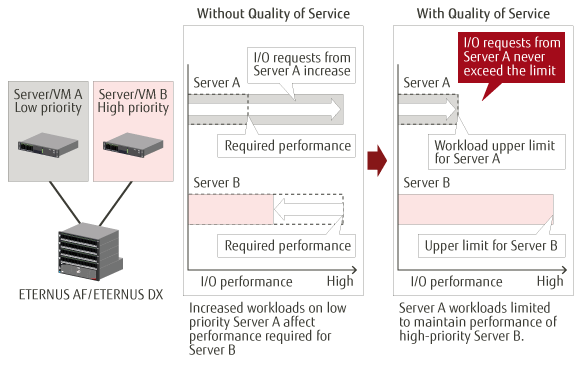Application I/O prioritization – Quality of Service
A prerequisite for any storage consolidation strategy is the ability to host multiple applications on a single storage platform without allowing the actions of one set of users to affect the I/O performance of others.
Potential problem areas for shared storage access include:
- Workloads with I/O and cache conflicts, such as online transaction processing (OLTP) and data warehousing
- Tiered storage access restrictions, such as development and production applications
- Peak processing demands for critical applications versus maintenance activities, such as backup or database reorganization
The Quality of Service feature with application I/O prioritization resolves these issues and enables the consolidation of multiple tiers of applications in a single storage system.
It sets performance limits for each connected server according to its priority. By prioritizing data access and dynamically managing any I/O conflict, high performance can be guaranteed for high-priority applications, and at the same time capacity is used more efficiently, thus increasing storage utilization without sacrificing performance. The QoS policies allow the user to specify the expected I/O patterns of each application (random, sequential, read or write-based, and mixed).
An example is shown in the figure below. Two servers are connected to an ETERNUS. Server B is granted a higher priority than server A. Accordingly, limits for I/O requests from both servers are set and server B has a higher limit than server A. In the event of increased workloads on the low-priority server A, the system limits the I/O performance at the predefined level and the performance of the high-priority server B is not affected. Thus the required I/O performance is guaranteed regardless of the workloads on other servers with lower priority.

The Quality of Service functionality provides higher degree of automation to ensure simpler and more intuitive settings.
The ETERNUS AF and ETERNUS DX (S3 or later) set values with ETERNUS SF Storage Cruiser Quality of Service management option based on performance requirements and dynamically adjusts the values along with the result of performance monitoring.
This feature makes it easier for the user to start the settings. Furthermore, the automatic tuning ensures that the values used are more accurate, resulting in better service level fulfillment.
In addition, an upper bandwidth limit of ETERNUS AF and ETERNUS DX (S3 or later) can be set for each copy path. Even if a specific path fails, a steady load can be maintained without centralizing the load to other paths.
Benefits
- Mapping application Service Level Agreements (SLA) to storage infrastructure
- Increased storage utilization by combining different workload profiles
- Allows service providers to guarantee a specific QoS and charge accordingly
Product Requirements
| Supported Storages | All-Flash Arrays | ETERNUS AF150 S3
ETERNUS AF250 S3/S2, AF250 ETERNUS AF650 S3/S2, AF650 ETERNUS DX200F |
|---|---|---|
| Hybrid Storage Systems | ETERNUS DX100 S5/S4/S3, DX200 S5/S4/S3
ETERNUS DX500 S5/S4/S3, DX600 S5/S4/S3 ETERNUS DX900 S5 ETERNUS DX8700 S3/S2, DX8900 S4/S3 ETERNUS DX80 S2, DX90 S2 ETERNUS DX400 S2 series |



